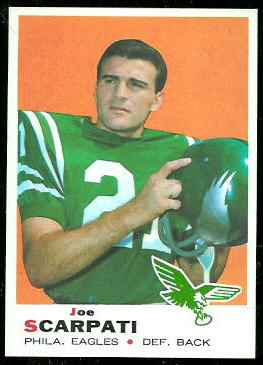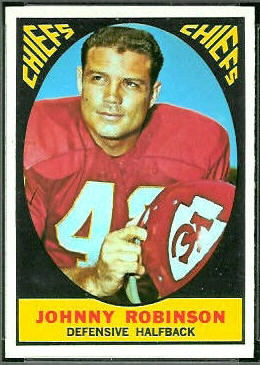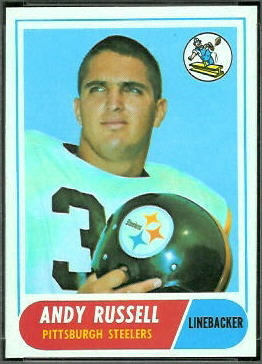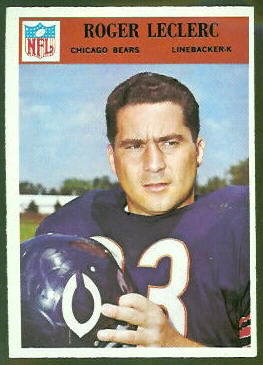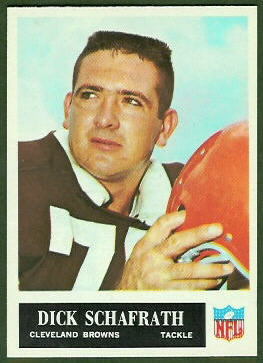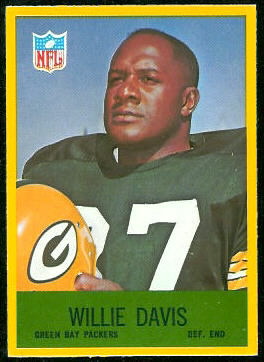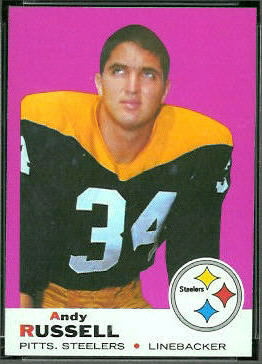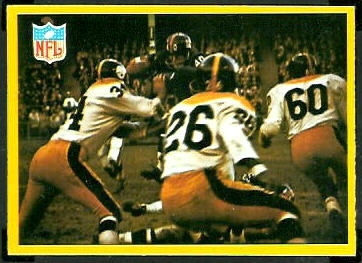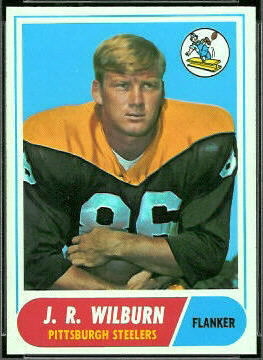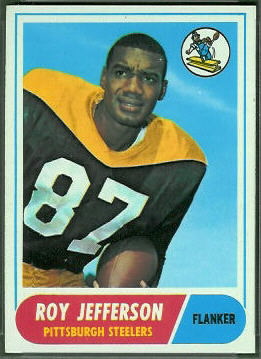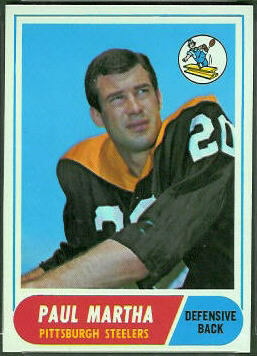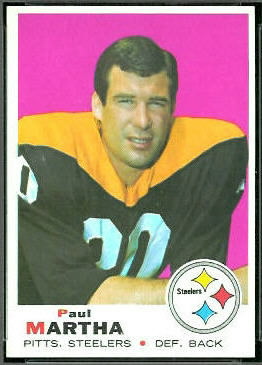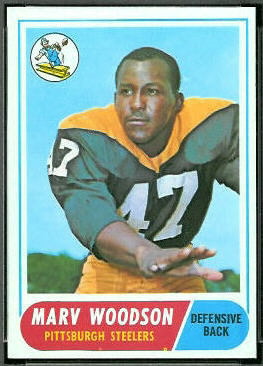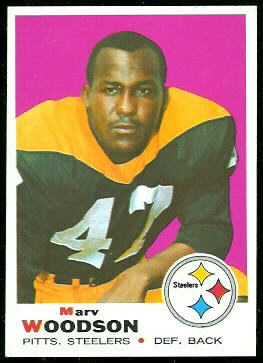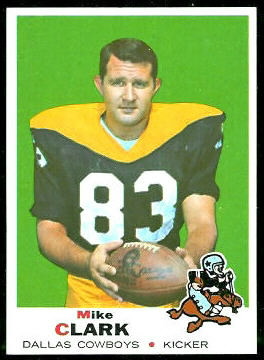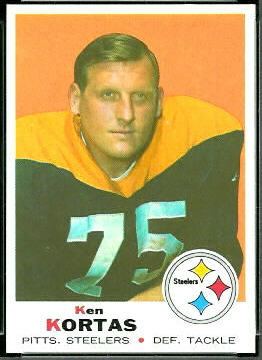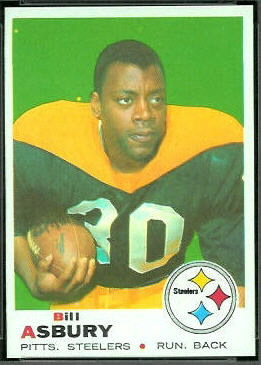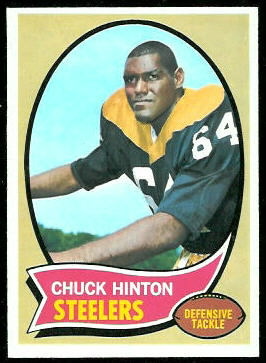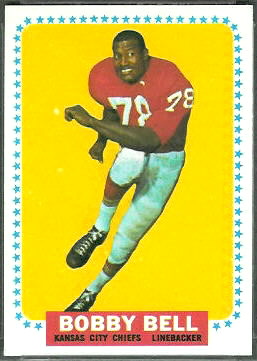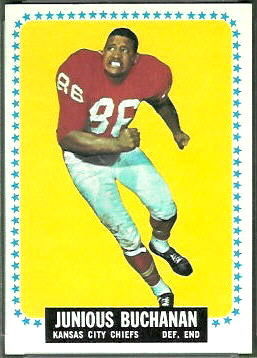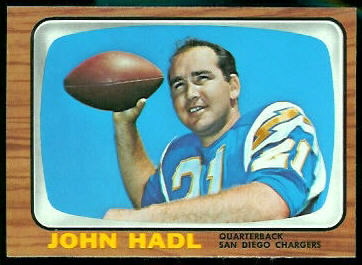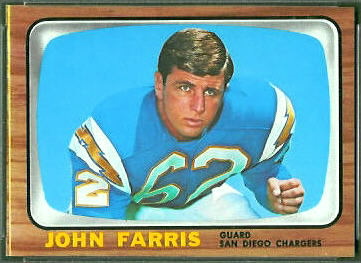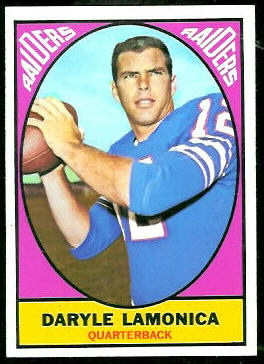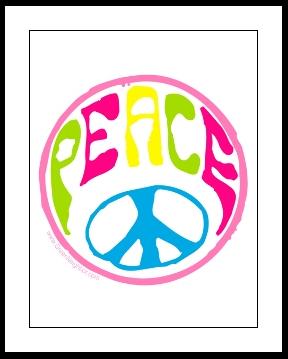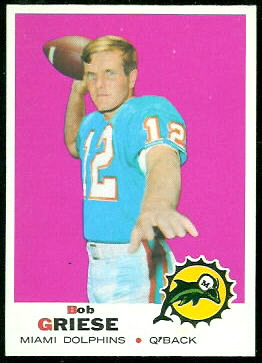Regional sets feature cards of players from only one team, and they were distributed in that team’s region by a local business, usually a food company. Because they cover only a single team, regional sets often include players who never appeared on a card from a major card company. They also often include cards of stars-to-be who did not appear in a major set until years later. There is a whole page of these “pre-rookie” cards in the Vintage Football Card Gallery.
Because they had a limited distribution, cards from regional sets are often challenging to find. The demand for them is typically also limited. I suspect that their scarcity is a turn-off to some collectors, and some collectors aren’t interested in cards of teams they don’t root for. For whatever reason, collectors’ interests seem to lie mostly with the major issues. I love the regionals, though.
1968 KDKA Steelers
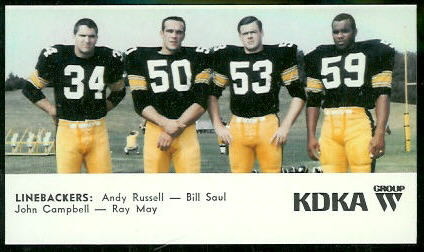 The cards in regional sets are often much different from the major companies’ offerings. 1968 KDKA Steelers cards, for example, are a non-standard size, they have a “landscape” orientation, they picture multiple players, and they have a glossy finish that was unusual at the time they were printed. They also include a card of the entire Steelers coaching staff, the only such vintage card I know of.
The cards in regional sets are often much different from the major companies’ offerings. 1968 KDKA Steelers cards, for example, are a non-standard size, they have a “landscape” orientation, they picture multiple players, and they have a glossy finish that was unusual at the time they were printed. They also include a card of the entire Steelers coaching staff, the only such vintage card I know of.
There are only 15 KDKA cards, but altogether they picture 46 players and coaches, grouped by position. This, too, is innovative, and I wonder why the major companies never did it. I don’t know how the cards were distributed, but KDKA is a television station in Pittsburgh that is still in operation. You can see the full KDKA Steelers set in the Vintage Football Card Gallery.
1960 Mayrose Cardinals
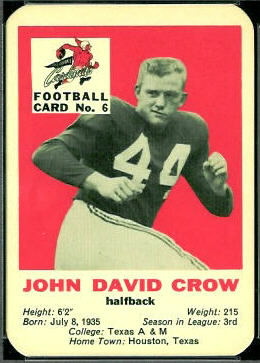 1960 Mayrose Cardinals cards are also an unusual shape, with rounded corners, like playing cards. Because the round corners hold up better than square ones, the cards I see are often in great condition. There are only eleven cards in the set, unfortunately, but since the Cardinals had few stars in 1960, the set does include a couple of players who never appeared in a major issue.
1960 Mayrose Cardinals cards are also an unusual shape, with rounded corners, like playing cards. Because the round corners hold up better than square ones, the cards I see are often in great condition. There are only eleven cards in the set, unfortunately, but since the Cardinals had few stars in 1960, the set does include a couple of players who never appeared in a major issue.
The Mayrose cards were distributed around St. Louis in packages of Mayrose franks and bacon. 1960 was the year that the Cardinals moved to St. Louis from Chicago, and I’d say that this regional issue is a sign that the city was excited about the move. Mayrose brand lunchmeats are still produced by Armour-Ekrich Meats, but to my knowledge they haven’t included cards since 1960. You can see the full Mayrose Cardinals set in the Vintage Football Card Gallery.
1961 Lake to Lake Packers
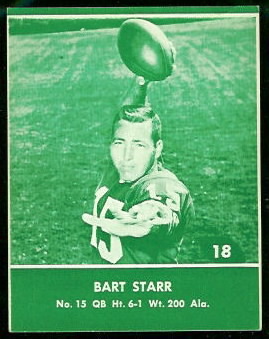 1961 Lake to Lake Packers cards were distributed by the Lake to Lake Dairy in Wisconsin. Half of the cards in the set are plentiful, and the other half were severely short-printed and are difficult to find. I estimate that the non-short prints outnumber the short prints ten-to-one. Some of the cards appear to have been stapled to the packages of the products they were distributed with, because the short prints I see on eBay often have staple holes or a corner ripped off where the staple had been. (A non-short print with staple holes would not be worth listing.)
1961 Lake to Lake Packers cards were distributed by the Lake to Lake Dairy in Wisconsin. Half of the cards in the set are plentiful, and the other half were severely short-printed and are difficult to find. I estimate that the non-short prints outnumber the short prints ten-to-one. Some of the cards appear to have been stapled to the packages of the products they were distributed with, because the short prints I see on eBay often have staple holes or a corner ripped off where the staple had been. (A non-short print with staple holes would not be worth listing.)
The Lake to Lake set includes four pre-rookie cards of Hall of Fame players: Herb Adderley, Ray Nitschke, Willie Davis, and Willie Wood. It also includes Bart Starr’s rarest card and Emlen Tunnell’s only card as a Packer. All of these except the Adderley are short prints. You can see the whole Lake to Lake Packers set in the Vintage Football Card Gallery. The short printed cards are identified there.
1959 and 1960 Bell Brand Rams
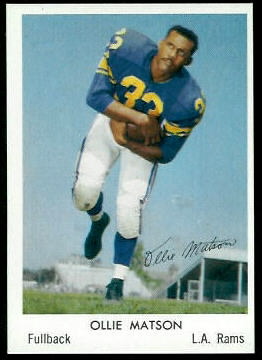 1959 and 1960 Bell Brand Rams cards were distributed in the Los Angeles area in packages of Bell Brand potato chips and corn chips. The cards are sturdy and attractive, with a high-gloss finish unlike other issues of the time. Unfortunately, particularly in the 1959 set, a great number of the cards were cut off-center. Each card features a facsimile of the player’s autograph, but some of the autographs are tiny relative to the size of the cards. It’s strange that someone designed such nice cards, but then put bitty autographs on them and cut them off-center.
1959 and 1960 Bell Brand Rams cards were distributed in the Los Angeles area in packages of Bell Brand potato chips and corn chips. The cards are sturdy and attractive, with a high-gloss finish unlike other issues of the time. Unfortunately, particularly in the 1959 set, a great number of the cards were cut off-center. Each card features a facsimile of the player’s autograph, but some of the autographs are tiny relative to the size of the cards. It’s strange that someone designed such nice cards, but then put bitty autographs on them and cut them off-center.
As I wrote when I added the set to the Gallery, the 1959 Bell Brand set contains a pre-rookie card of Hall of Fame coach Sid Gillman. Gillman left the Rams after the 1959 season to become the first head coach of the Chargers. The set also contains a pre-rookie card of Ed Meador, whose web site I featured in an earlier post.
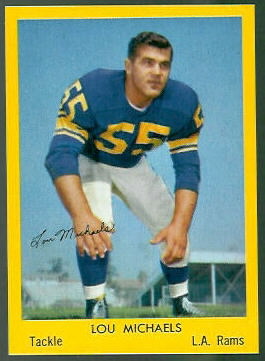 As I wrote in yet another post, the 1960 Bell Brand set appears to have been released in two series. Both series are scarce, and the second series is scarcer than the first. One card, Gene Selawski, was reportedly pulled from distribution when he left the team early in the season.
As I wrote in yet another post, the 1960 Bell Brand set appears to have been released in two series. Both series are scarce, and the second series is scarcer than the first. One card, Gene Selawski, was reportedly pulled from distribution when he left the team early in the season.
Between the two sets, I see 12 or 15 players that did not appear in any other set. Because of that, and because the cards are so attractive, I’d call these my favorite regional cards. You can see most of the 1959 Bell Brand set and over half of the 1960 set in the Vintage Football Card Gallery.
1961 Golden Tulip Chargers
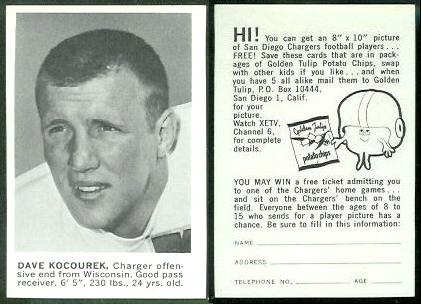 Like the Bell Brand Rams, 1961 Golden Tulip Chargers cards were distributed in bags of potato chips. Unlike the Bell Brands, they are small (about 20% shorter than a standard card), black and white, and plain. The card stock is thin, more like thick paper than cardboard, and the cards appear to have been hand cut from a bigger sheet. The backs of the cards advertise an 8-by-10 picture of the Chargers that you could obtain by turning in 5 cards of the same player. It’s hard to guess how many cards the offer took out of circulation.
Like the Bell Brand Rams, 1961 Golden Tulip Chargers cards were distributed in bags of potato chips. Unlike the Bell Brands, they are small (about 20% shorter than a standard card), black and white, and plain. The card stock is thin, more like thick paper than cardboard, and the cards appear to have been hand cut from a bigger sheet. The backs of the cards advertise an 8-by-10 picture of the Chargers that you could obtain by turning in 5 cards of the same player. It’s hard to guess how many cards the offer took out of circulation.
Like the 1960 Mayrose Cardinals, the 1961 Golden Tulip cards celebrated the arrival of a new team in town. After spending their first year in Los Angeles, the Chargers moved to San Diego in 1961.
The best thing about the Golden Tulip set is that 6 of the 22 cards feature players that I don’t believe appeared on any other cards. You can see all of the Golden Tulip cards in the Vintage Football Card Gallery.
1969 Tresler Comet Bengals
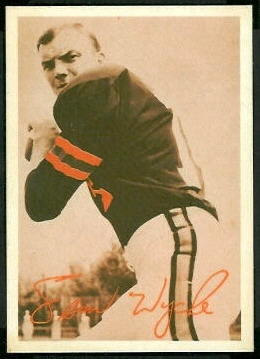 1969 Tresler Comet Bengals cards were given away at Tresler Comet gas stations around Cincinnati. The cards are on thin cardboard stock, and the pictures are brown and white, except for the players’ numbers and facsimile signatures being colored orange. The brown, white, and orange is not a particularly attractive effect, but it is another example of the creativity seen in regional cards.
1969 Tresler Comet Bengals cards were given away at Tresler Comet gas stations around Cincinnati. The cards are on thin cardboard stock, and the pictures are brown and white, except for the players’ numbers and facsimile signatures being colored orange. The brown, white, and orange is not a particularly attractive effect, but it is another example of the creativity seen in regional cards.
To me the highlight of the set is Sam Wyche. I believe this is his only card as a player. You can see the whole set of Tresler Comet cards in the Vintage Football Card Gallery.
1967 Royal Castle Dolphins
 1967 Royal Castle Dolphins cards, according to the backs of the cards, were free to Royal Castle Junior Dolphin members at Royal Castle restaurants. The card backs say that two cards (actually they say “photos”) would be available each week during the season.
1967 Royal Castle Dolphins cards, according to the backs of the cards, were free to Royal Castle Junior Dolphin members at Royal Castle restaurants. The card backs say that two cards (actually they say “photos”) would be available each week during the season.
Apparently not many Junior Dolphins took advantage of the offer, because the cards are extremely scarce. I have only 17 of the 27 cards, and the remaining 10 are short prints. Among the short prints is a Bob Griese pre-rookie card, of which I have only seen pictures. One of the pictures is on the SGC web site.
The Royal Castle cards are big, about 25% taller and wider than a standard card. Surprisingly, though 1967 was just the Dolphins’ second year in the league, only five or so of the players in the set did not appear on cards in major issues. Most of the other players appeared in at least one of the 1964-1967 Topps AFL sets, which included a large number of players from each team.
You can see most of the 1967 Royal Castle Dolphins cards in the Vintage Football Card Gallery. I would like to get the rest, so if any of you Junior Dolphins have some to sell, let me know!
1961 National City Bank Browns
 1961 National City Bank Browns cards were distributed on 6-card panels from which you could cut the cards by hand. There were 6 panels of cards, so there are 36 cards in the set: 35 player cards, and one unnumbered Quarterback Club card. Including the Quarterback Club card in the set seems goofy to me, but both PSA and Beckett include it, so what do I know?
1961 National City Bank Browns cards were distributed on 6-card panels from which you could cut the cards by hand. There were 6 panels of cards, so there are 36 cards in the set: 35 player cards, and one unnumbered Quarterback Club card. Including the Quarterback Club card in the set seems goofy to me, but both PSA and Beckett include it, so what do I know?
Surprisingly, though 35 cards covered most of the players on the team, by my count only 5 of the players did not appear on cards in any other set. The Browns were one of the top teams in the early 1960’s, and evidently most of their players were card-worthy.
My favorite card in the set is a Len Dawson pre-rookie card. Dawson played several years for the Steelers and Browns before jumping to the AFL.
You can see the whole set of 1961 National City Bank Browns cards in the Vintage Football Card Gallery.
